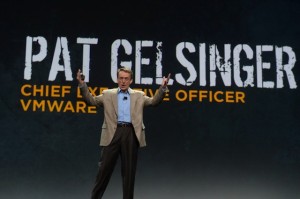 For a bloke who might be set to take over Dell, VMware boss “Kicking” Pat Gelsinger is in no mood to talk about it.
For a bloke who might be set to take over Dell, VMware boss “Kicking” Pat Gelsinger is in no mood to talk about it.
When chatting on an earnings call, Gelsinger said he would not comment on “rumours” that VMware could acquire Dell in a reverse merger, after Dell confirmed in February that it was exploring various options.
However, analysts think the reverse merger idea is rather a good one, and the rumours are somewhat more than that. Gelsinger is not exactly forthcoming and no one wants to get on the wrong side of his mighty boot.
VMware is doing quite well. For the three months ending 2 February, VMware saw revenue jump 14 percent year on year to $2.31 billion. GAAP losses were $440 million (compared with a GAAP profit of $441 million in 2016) as a result of a one-off $970 million tax bill.
Hybrid cloud and software-as-a-service accounted for eight per cent of VMware’s total revenue.
“We are very pleased with customer enthusiasm for our cloud strategy. We believe we have the world’s most complete and capable hybrid cloud architecture, uniquely offering customers freedom and control in their infrastructure decisions.
“We are also pleased with the traction the VMware Cloud Provider Programme continues to gain. The VMware Cloud Provider Programme achieved an annual revenue growth rate of over 30 per cent in the fiscal year 2018.
“We are also experiencing great global customer momentum with our VMware Cloud for IBM with customers such as Amdocs, Ricoh and Vodafone.”
Gelsinger also highlighted the future importance of VMware’s partnership with Amazon Web Services (AWS), which recently launched in the US. The CEO said the service is set to launch in Europe next week.
“The VMware Cloud on AWS continues to get great resonance from our customers, and customers see this idea of the best of public and the best of private coming together as a very powerful force”, he said.
“In many cases, it’s this unique way for them to accelerate their move to the cloud without disrupting their applications – being able to do this in a seamless hybrid way to move into the public and back to the private cloud.
“From the business, as we said, it’s not material this year, and it’s starting to build up. We also see that, given it’s a subscription business, that will also delay the direct fiscal impact.”





